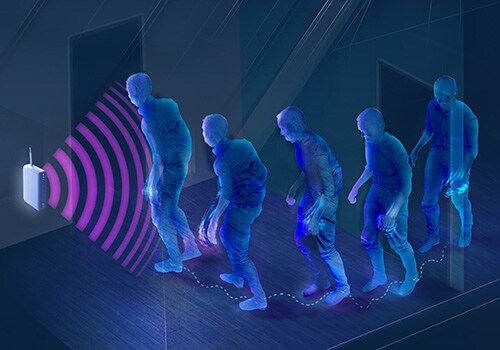An in-home wireless device that monitors movements and gait speed of patients with Parkinson's disease (PD) could allow clinicians to monitor disease progression using a type of "human radar," a new study suggests.
Roughly the size of a Wi-Fi router, the device is mounted on a wall in the home and gathers data about movement and gait speed using radio signals that bounce off the patient's body as they move. Changes in these movements are potential indicators of disease progression and severity and medication response.
When researchers compared a year's worth of data collected with the device to conventional clinical measurements of Parkinson's, they found that clinicians could track the disease and medication response more effectively than they could with periodic, in-clinic evaluations.

Roughly the size of a Wi-Fi router, the in-home wireless device is mounted on a wall and gathers data about movement and gait speed using radio signals that bounce off the patient's body as they move.
"Parkinson's symptoms get worse over time, but the disease changes slowly and sometimes it takes many years to assess reliably the change in disease severity," investigator Dina Katabi, PhD, professor of electrical engineering and computer science at the Massachusetts Institute of Technology in Cambridge, told Medscape Medical News. "We can shorten this period because we have more reliable and sensitive measurements."
The findings were published online September 21 in Science Translational Medicine.
Meets the Gold Standard
Oral levodopa is the gold standard medication for improving the symptoms of Parkinson's disease, which affects about 1% of people older than age 60. The drug's effectiveness wanes in most patients after a few years, however, so routine monitoring of motor skills and cognitive function is critical.
Because most PD specialists are concentrated in urban areas, as many as 40% of Medicare patients are rarely seen by a neurologist or specialist, if at all.
This has spurred research into alternative ways to monitor the disease outside the clinic. While wearable devices have shown some results, the age and frailty of many patients presents challenges to their successful use.
The device used in this study, developed in Katabi's lab, sends out wireless signals that are about 1000 times weaker than those emitted by a home Wi-Fi system. The signals travel through walls and objects but bounce off a person's body as they move.
Researchers collected data for 1 year from 1-2 devices placed in the homes of 34 patients with PD and 16 healthy participants. Using machine-learning algorithms, investigators analyzed more than 200,000 gait speed measurements.
Investigators found that in-home gait speed was strongly correlated with scores on the Movement Disorder Society-Sponsored Revision of the Unified Parkinson's Disease Rating Scale part III subscore and total score (P < .001 for both).
"The study shows that the gait at home is more correlated with the gold standard in measuring Parkinson's disease," Katabi said.
Researchers also found that annual gait speed declined nearly twice as fast in individuals with PD as in those without the disorder (−0.026 m/s vs −0.015 m/s, respectively; P = .04). Gait measurements also lined up with medication usage; gait speed improved soon after a patient took their medication and declined as the medication began to wear off.
"It allows doctors to assess the disease without asking patients to visit the clinic, which is typically difficult for old patients due to motor impairment in Parkinson's disease," Katabi said.
Clinical Impact
The researchers have conducted several studies on devices such as the one used in this trial, including artificial intelligence (AI) technology that uses a neural network to mimic the human brain.
Researchers used that device to successfully distinguish between patients with PD and those without the disorder, based on nocturnal breathing signals. The technology even identified those with PD before they were diagnosed.
Using machine-learning algorithms in this way has the potential to speed drug development by simplifying clinical trials and reducing their cost, the researchers said. But for PD specialists, the more immediate interest is how the technology might improve patient care.
Commenting on the findings for Medscape Medical News, Rebecca Gilbert, MD, PhD, chief scientific officer of the American Parkinson Disease Association, said the device in this new study could "add a vital component to the monitoring of PD, which at this point consists of data collected at wide intervals in the clinic.
"Using home gait speed could be exceptionally useful for clinicians not only to understand their patient's clinical state and progression, but to examine response to their clinical decisions such as medication changes," Gilbert added.
The study was funded by the National Institutes of Health and the Michael J. Fox Foundation. Katabi is a co-founder of Emerald Innovations and serves on the advisory board of Janssen and the data science advisory board of Amgen. Gilbert reports no relevant financial relationships.
Sci Transl Med. Published online September 21, 2022. Full text
Kelli Whitlock Burton is a reporter for Medscape Medical News who covers psychiatry and neurology.
For more Medscape Neurology news, join us on Facebook and Twitter
Credits:
Images: N.Fuller, SayoStudio
Medscape Medical News © 2022 WebMD, LLC
Send news tips to news@medscape.net.
Cite this: In-Home Device May Best 'Gold Standard' for Parkinson's Monitoring - Medscape - Sep 23, 2022.











Comments